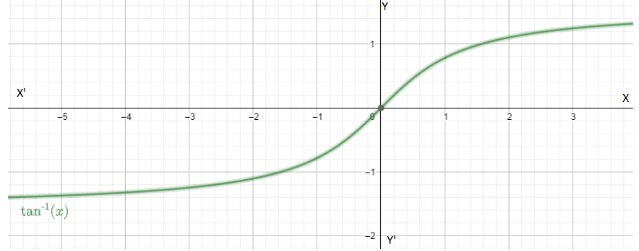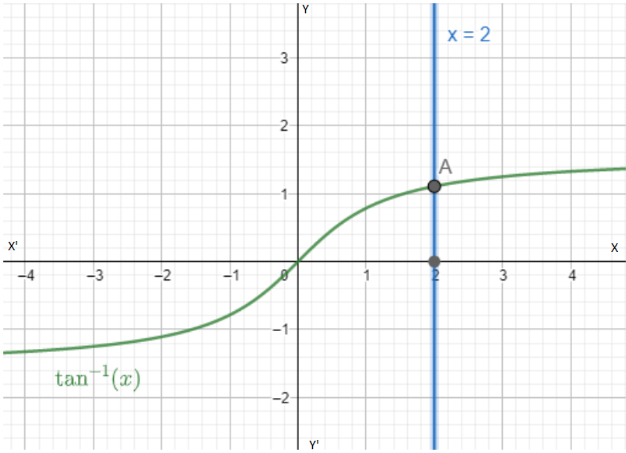
Which value of tan is 2?
Answer
492.9k+ views
Hint: We explain the function $arc\tan \left( x \right)$. We express the inverse function of tan in the form of $arc\tan \left( x \right)={{\tan }^{-1}}x$. We draw the graph of $arc\tan \left( x \right)$ and the line $x=2$ to find the intersection point as the solution.
Complete step by step answer:
The given expression is the inverse function of trigonometric ratio tan which gives us the value. The arcus function represents the angle which on ratio tan gives the value. So, $arc\tan \left( x \right)={{\tan }^{-1}}x$. If $arc\tan \left( x \right)=\alpha $ then we can say $\tan \alpha =x$.Each of the trigonometric functions is periodic in the real part of its argument, running through all its values twice in each interval of $2\pi $.
The general solution for that value where $\tan \alpha =x$ will be $n\pi +\alpha ,n\in \mathbb{Z}$. But for $arc\tan \left( x \right)$, we won’t find the general solution. We use the principal value. For the ratio tan we have $-\dfrac{\pi }{2}\le arc\tan \left( x \right)\le \dfrac{\pi }{2}$. The graph of the function is

$arc\tan \left( x \right)=\alpha $ gives the angle $\alpha $ behind the ratio.
We now place the value of $x=2$ in the function of $arc\tan \left( x \right)$.
Let the angle be $\theta $ for which $arc\tan \left( 2 \right)=\theta $. This gives $\tan \theta =2$.
Putting the value in the graph of $arc\tan \left( x \right)$, we get $\theta =63.43$.
For this we take the line of $x=2$ and see the intersection of the line with the graph $arc\tan \left( x \right)$.

Therefore, the value of $arc\tan \left( 2 \right)$ is ${{63.43}^{\circ }}$.
Note: First note that the value 2 looks suspiciously like it was intended to be an angle but the argument of the $arc\tan \left( x \right)$ function is not an angle. The representation will be the right-angle triangle with base 1 and height 2 and the angle being $\theta $.
Complete step by step answer:
The given expression is the inverse function of trigonometric ratio tan which gives us the value. The arcus function represents the angle which on ratio tan gives the value. So, $arc\tan \left( x \right)={{\tan }^{-1}}x$. If $arc\tan \left( x \right)=\alpha $ then we can say $\tan \alpha =x$.Each of the trigonometric functions is periodic in the real part of its argument, running through all its values twice in each interval of $2\pi $.
The general solution for that value where $\tan \alpha =x$ will be $n\pi +\alpha ,n\in \mathbb{Z}$. But for $arc\tan \left( x \right)$, we won’t find the general solution. We use the principal value. For the ratio tan we have $-\dfrac{\pi }{2}\le arc\tan \left( x \right)\le \dfrac{\pi }{2}$. The graph of the function is

$arc\tan \left( x \right)=\alpha $ gives the angle $\alpha $ behind the ratio.
We now place the value of $x=2$ in the function of $arc\tan \left( x \right)$.
Let the angle be $\theta $ for which $arc\tan \left( 2 \right)=\theta $. This gives $\tan \theta =2$.
Putting the value in the graph of $arc\tan \left( x \right)$, we get $\theta =63.43$.
For this we take the line of $x=2$ and see the intersection of the line with the graph $arc\tan \left( x \right)$.

Therefore, the value of $arc\tan \left( 2 \right)$ is ${{63.43}^{\circ }}$.
Note: First note that the value 2 looks suspiciously like it was intended to be an angle but the argument of the $arc\tan \left( x \right)$ function is not an angle. The representation will be the right-angle triangle with base 1 and height 2 and the angle being $\theta $.
Recently Updated Pages
Master Class 11 Economics: Engaging Questions & Answers for Success

Master Class 11 English: Engaging Questions & Answers for Success

Master Class 11 Social Science: Engaging Questions & Answers for Success

Master Class 11 Biology: Engaging Questions & Answers for Success

Class 11 Question and Answer - Your Ultimate Solutions Guide

Master Class 11 Business Studies: Engaging Questions & Answers for Success

Trending doubts
What is meant by exothermic and endothermic reactions class 11 chemistry CBSE

10 examples of friction in our daily life

One Metric ton is equal to kg A 10000 B 1000 C 100 class 11 physics CBSE

Difference Between Prokaryotic Cells and Eukaryotic Cells

What are Quantum numbers Explain the quantum number class 11 chemistry CBSE

1 Quintal is equal to a 110 kg b 10 kg c 100kg d 1000 class 11 physics CBSE




